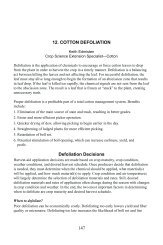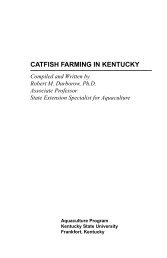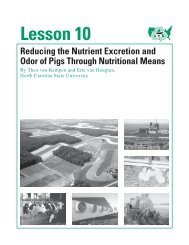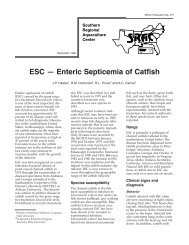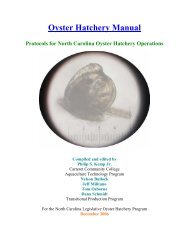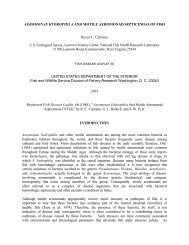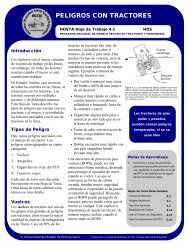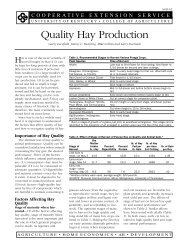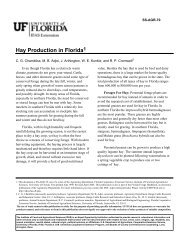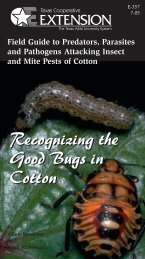Dryland Pastures in Montana and Wyoming - MSU Extension
Dryland Pastures in Montana and Wyoming - MSU Extension
Dryland Pastures in Montana and Wyoming - MSU Extension
You also want an ePaper? Increase the reach of your titles
YUMPU automatically turns print PDFs into web optimized ePapers that Google loves.
species. In clayey soils, stubble decreases soil crust<strong>in</strong>g which aids seedl<strong>in</strong>g emergence.<br />
Nurse or companion crops are not recommended with grass seed<strong>in</strong>g.<br />
Tim<strong>in</strong>g of Seed<strong>in</strong>g<br />
Proper seed<strong>in</strong>g techniques <strong>and</strong> equipment are critical to all forage seed<strong>in</strong>gs, but<br />
are most critical under dryl<strong>and</strong> conditions. <strong>Dryl<strong>and</strong></strong> pasture seed<strong>in</strong>g should occur<br />
<strong>in</strong> early spr<strong>in</strong>g to capitalize on potential late snows <strong>and</strong> early ra<strong>in</strong>s. “Dormant”<br />
seed<strong>in</strong>g of grasses (but not legumes) is successful <strong>in</strong> the late fall or w<strong>in</strong>ter, as long<br />
as w<strong>in</strong>ter annual weeds (e.g., cheatgrass) are not abundant <strong>and</strong> soil temperatures<br />
rema<strong>in</strong> too low for seed germ<strong>in</strong>ation until the follow<strong>in</strong>g spr<strong>in</strong>g. Late-summer seed<strong>in</strong>gs<br />
should only be planted if supplemental moisture is available from stored soil<br />
moisture or irrigation. A m<strong>in</strong>imum of 2 feet of moist soil is needed for successful<br />
plant establishment. Seed<strong>in</strong>g at other times should be avoided due to unreliable<br />
precipitation.<br />
Row Spac<strong>in</strong>g<br />
Proper seedl<strong>in</strong>g density leads to faster establishment, weed suppression <strong>and</strong><br />
optimum forage production under dryl<strong>and</strong> conditions. Generally, most grasses<br />
<strong>and</strong> legumes are sown <strong>in</strong> 12- to 14-<strong>in</strong>ch rows, whereas Russian wildrye performs<br />
best <strong>in</strong> 18- to 24-<strong>in</strong>ch rows. Row spac<strong>in</strong>g can be controlled on conventional drills<br />
by block<strong>in</strong>g several of the open<strong>in</strong>gs above the seed tubes. Us<strong>in</strong>g wide row spac<strong>in</strong>gs<br />
may require clipp<strong>in</strong>g <strong>and</strong>/or use of labeled herbicides for establishment-year weed<br />
control. When plant<strong>in</strong>g grass/legume mixtures, alternate rows of legume <strong>and</strong> grass<br />
are recommended.<br />
Seed Placement<br />
Seed<strong>in</strong>g technique can <strong>in</strong>fluence seedl<strong>in</strong>g establishment much more than <strong>in</strong>herent<br />
differences among species. Most forage species have small seeds that require<br />
precise, shallow placement. In addition, most forage species germ<strong>in</strong>ate <strong>and</strong> emerge<br />
slower than cereal gra<strong>in</strong>s. Others have dormant seed requir<strong>in</strong>g over-w<strong>in</strong>ter stratification.<br />
Crested wheatgrass <strong>and</strong> <strong>in</strong>termediate wheatgrass are among the easiest<br />
species to establish, while Russian <strong>and</strong> Altai wildrye are generally more difficult.<br />
Indian ricegrass <strong>and</strong> green needlegrass have dormant seed, are slow to establish <strong>and</strong><br />
do best when dormant seeded <strong>in</strong> the late fall. Forage seeds should be planted at the<br />
appropriate seed<strong>in</strong>g rate <strong>in</strong>to a firm seedbed <strong>and</strong> at a depth of less than one-half<br />
<strong>in</strong>ch. This is best accomplished with a drill that has depth b<strong>and</strong>s, a seed agitator<br />
<strong>and</strong> packer wheels. Rice hulls or cracked corn can be used as a carrier to assist seed<br />
flow through the drill for uniform seed distribution.<br />
— 17 —




